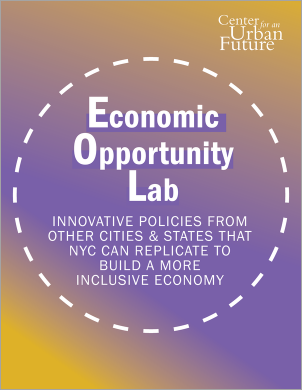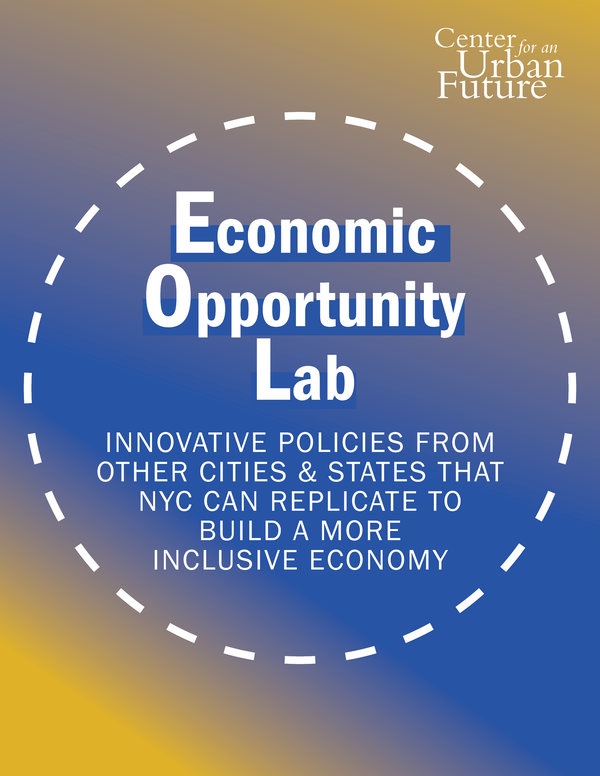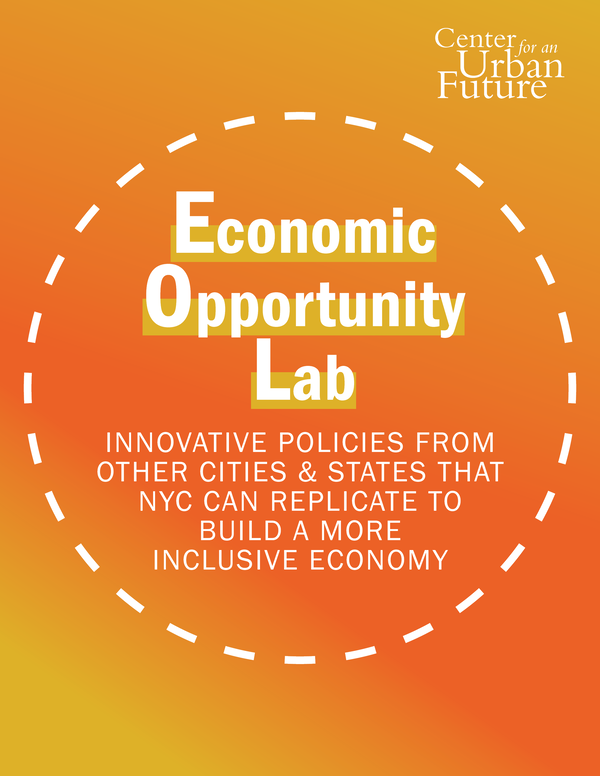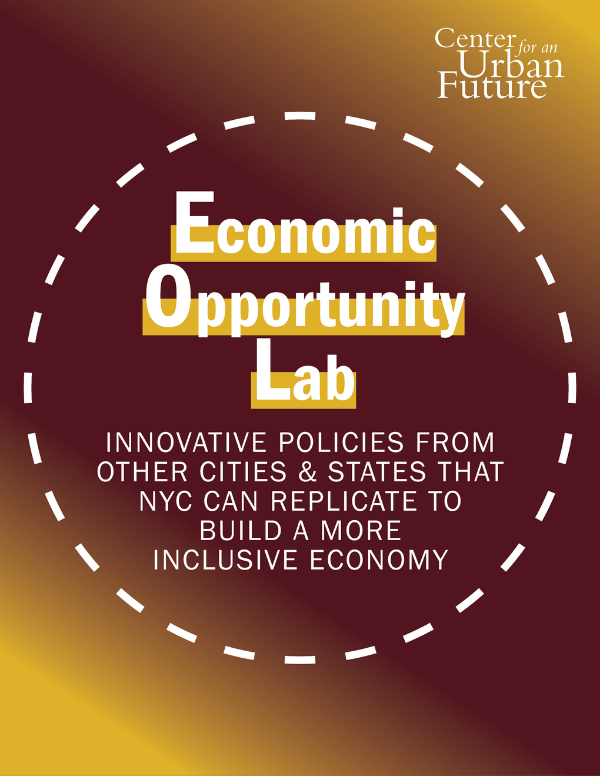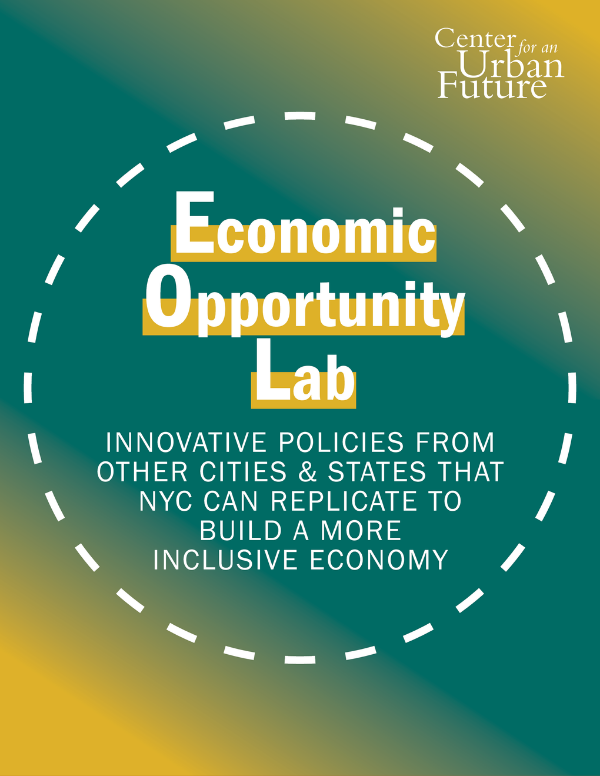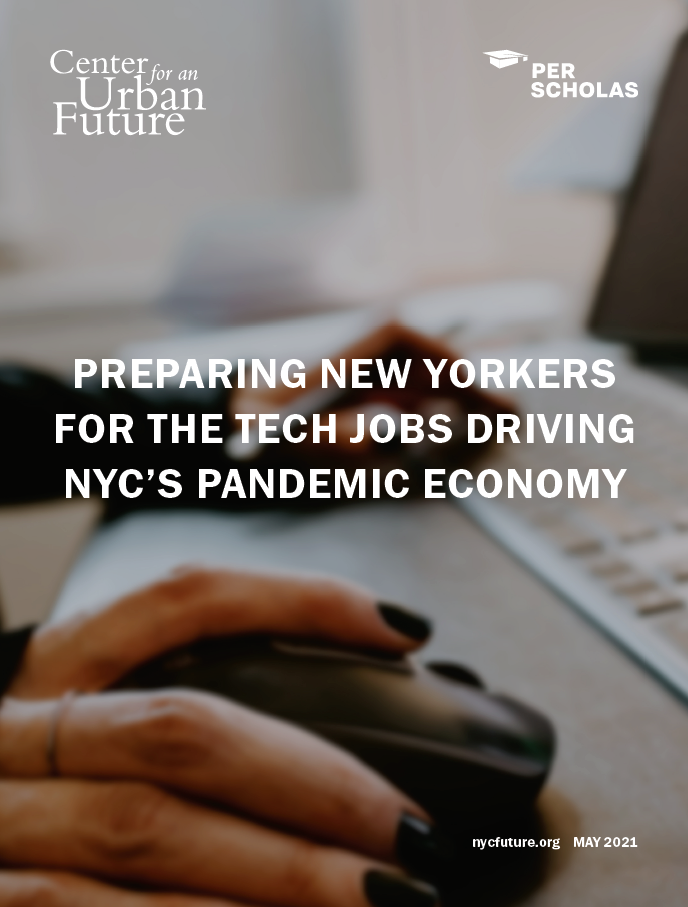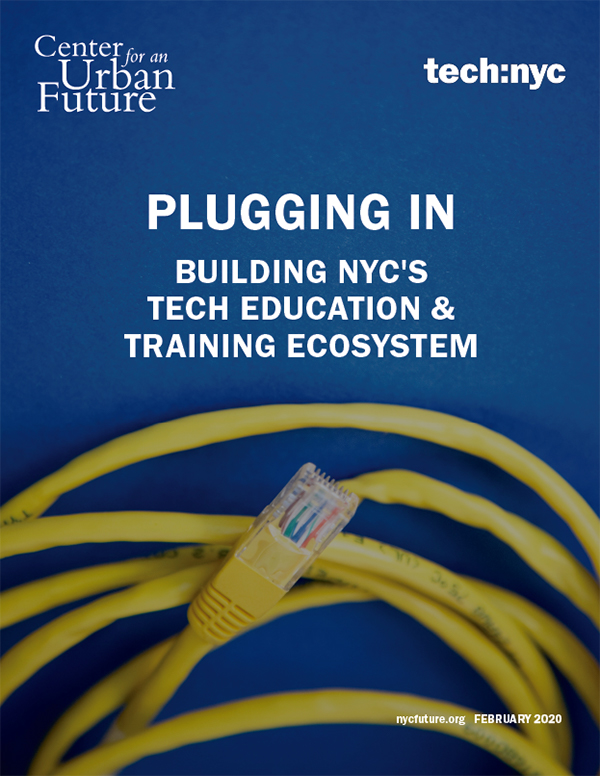
One of the keys to the creating a more equitable economy in New York will be ensuring that many more New Yorkers from low-income backgrounds are able to access the good jobs that are growing today, in fields like tech, healthcare, and advertising. This will require getting thousands more New Yorkers into high-quality workforce training programs. But for this to happen, Mayor-elect Adams and the City Council will need to address a major shortcoming of the city’s workforce development system: New York’s most effective training programs typically serve only a few dozen to a few hundred people a year, and the nonprofits that run them find it nearly impossible to scale up due not just to limited public dollars but to restrictions on how workforce dollars are meted out. While greatly expanding city support for workforce development is an important first step, city officials would also be wise to experiment with new models. A promising one was created right across the Hudson.
New Jersey's Pay It Forward program, launched in October 2020, creates the first ever state-backed career impact bond, a public-private financing mechanism that allows low-income residents access to job training at no up-front cost, only paying back the cost of education through an income-sharing agreement after they’ve obtained a well-paying job in their desired sector. By publicly seeding and encouraging private investments in the future career success of its residents, New Jersey may have unlocked a novel, innovative way to allow the most successful workforce training programs to scale up.
The COVID-19 pandemic has only added to the importance of skills-building, disproportionately erasing swaths of low-wage jobs where little formal education is required—many of which will not return in the recovery. Ensuring that New Yorkers most in need of job training can access the skills-building necessary to succeed in sectors leading the city’s rebound will require new strategies.
“New York City still has a 10 percent unemployment rate. Most of it has been blue-collar workers from communities of color,” says Jukay Hsu, the CEO of Pursuit, a software developer training program in Queens. “Lots of these jobs are not coming back. So to enable New York’s recovery, the focus should be [getting] the skills required to do that.”
After a crisis that eliminated once-reliable jobs and left many occupations increasingly vulnerable to automation, New Yorkers will be looking for opportunities to switch to more promising industries that pay better wages and can withstand the next downturn and disruption. But right now, most of the city’s high-quality tech training programs are prohibitively costly to the low-income residents who most need to skill up. The few programs that provide free, intensive training and have highly successful placement records can train at most a few hundred participants per year, in large part due to limited funding.
Expanding successful skills-building programs in the coming years will require new financing mechanisms that can scale with demand at a time when public dollars are likely to be in short supply. New Jersey’s Pay It Forward program provides a concrete pathway to pooling together public and private financing to bring successful job training to the people who need it most.
The Policy
In October 2020, New Jersey announced that it would create the Pay It Forward program as part of the state’s ongoing COVID recovery efforts. The program issues a career impact bond to low-income residents that pays for both job training and wraparound services like childcare and transportation. The bond is later repaid through a portion of income only once the trainee reaches a specific salary threshold at a new well-paying job in their desired field.
While different models exist, New Jersey’s income-sharing agreement doesn’t offer returns to investors like private counterparts; instead, its model recycles the repaid money to the next applicant, thereby “paying it forward.” If a student is unable to secure a high-paying job in the sector they’re pursuing, they are off the hook for the bond, and if they can’t repay in full within five years, the remaining balance is forgiven.
New Jersey, like several other states, had previously launched "free college" programs that helped more low-income residents afford the high costs of enrolling in college. But while those efforts to expand access to college are important, most low-income adults aren't looking to enroll in college. They could, however, greatly benefit from short-term but intensive workforce development programs that help them quickly acquire new skills and credentials. Unfortunately, there has been no similar free college–style effort for workforce training—until the Pay It Forward program—to address this gap.
“We feel like we’ve made a significant amount of investment to open doors for people who are looking to enroll in associate’s and bachelor’s degrees,” says Tara Colton, executive vice president for special projects of the New Jersey Economic Development Authority, which is leading the effort. “But when you look at the universe of what’s available [for short-term training] through publicly funded workforce systems or philanthropically supported programs, there is a gap.”
Like New York City, the state of New Jersey is home to a robust ecosystem of skill training providers. But while providers have helped residents secure jobs in fast-growing industries, the training programs that do exist tend to be time-consuming and costly. There are just a handful of nonprofit programs with enough government funding and philanthropic support to provide quality, intensive training free of charge to lower-income residents. These programs serve just a fraction of the people who most need to upskill and must turn away the vast majority of applicants.
The disparity in access drove New Jersey Governor Phil Murphy’s administration to look for new ways to fund intensive, short-term training and credentialing in the sectors driving economic growth. The idea of a career impact bond—which has attracted significant attention nationally—emerged as an opportunity to do just that.
The New Jersey CEO Council, an informal group of the state’s largest companies formed during the pandemic, has committed $5.5 million to the Pay It Forward program, with the state matching. Those eligible include residents on public assistance, the long-term unemployed, the formerly incarcerated, or those adversely impacted (rendered unemployed or underemployed) by COVID-19. The program is a ‘last dollar’ option, providing zero-interest loans for only the money left over after students have exhausted all funds offered by the state. Loans can only be spent on state-approved training programs in high-demand fields with a track record of success.
“New Jersey is looking at funding short-term certificate and credential programs that aren’t eligible for [federal student loans],” says Jake Edwards, the vice president of Social Finance, a national nonprofit that works with municipalities to implement career impact bonds. “These programs generally have out-of-pocket tuition costs, which means individuals that are low-income or stuck in cycles of underemployment can’t access them. So New Jersey zeroed in on that barrier.” (Social Finance will be administering Pay It Forward.)
Because the bond is state-administered, New Jersey sets the terms of the bond and establishes key student protections, like a repayment percentage that factors in discretionary living costs and no-cost wraparound services. By playing the lead financing role, the state can ensure these crucial “guardrails” hold up.
New York–based workforce experts think the city should take a similar approach to make career impact bonds effective in the five boroughs.
“I think the terms need to be structured in such a way that would allow for some flexibility [in repayment],” says Jose Ortiz Jr., chief executive officer of the New York City Employment and Training Coalition (NYCETC), the largest association of workforce development providers in the city. “If not built incredibly well, [the bond] will have a net negative impact on the population that’s being served, and not a net positive.”
Ortiz says attention should be paid to aligning the salary thresholds for repayment to the industry-standard salaries promised by service providers. Otherwise, students could be left in a harmful situation where they’re repaying a bond without actually obtaining the well-paying job it promises. Other elements of the New Jersey model, such as loan forgiveness after five years and a zero percent interest rate, can help ensure that the financing model protects the best interests of borrowers.
“The incredible beauty of our city is that it is a melting pot in its diversity, but it also makes it much more complex, from a workforce standpoint. And the result is, we need a diverse group of players at the table,” says Ortiz. “But I’m excited about the possibility of this and what it could mean.”
The Challenges
Bond-funded training linked to income-sharing agreements already exists in New York City, but only through specific tech training providers that are highly competitive and relatively small in scale, such as General Assembly and App Academy. The model allows tech training providers with a rigorous admissions processes and strong post-program placement records to offer training to students who lack the capital or credit they would need to pay for up-front costs. Investors bear the risk, while students only pay back tuition after they’re employed in industry.
Pursuit is unique among providers with an income sharing agreement in that it offers training exclusively to lower-income New Yorkers, and social impact investors cover the upfront costs. Before launching the Pursuit Bond, the organization relied solely on grants and philanthropy. Pursuit’s success with the career impact bond model comes down to their excellent outcomes: graduates see their average annual salaries jump from $18,000 to $85,000 post-program, with 85 percent of graduates landing jobs at companies like Kickstarter, Apple, and Spotify. But this track record is due in part to Pursuit’s vetting process; the organization accepts less than 10 percent of applicants. Just over 300 people have graduated from the program to date.
Far greater reach and accessibility are needed, experts agree, to address mounting demand. While New Jersey’s Pay It Forward program is in its initial stages, it is expected to train thousands of residents in the next few years.
A New York City model may look different in scope than its neighbor, but ultimately it could help bridge three major gaps in 21st-century workforce development:
1. Lack of public dollars for skills training
In 2019, at a time of strong economic growth, the city’s Department of Small Business Services (SBS) and its partner agencies provided occupational training for 28,000 New Yorkers and helped connect more than 73,000 people with jobs, mostly in lower-wage sectors with low barriers to employment. But current rates of unemployment and underemployment suggest that several times that number of New Yorkers will need to find employment in new sectors as the economy shifts in response to the pandemic, the growth of automation, and other factors. And the well-paying jobs of the future will increasingly require a much different skill set.
Federal funding for this level of workforce mobilization has remained limited for years. The city dollars committed each budget cycle are scarce: according to NYCETC, less than one percent of the city’s nearly $100 billion budget went to workforce development in FY2021. The dollars from philanthropic sources and corporate funders are also very limited; according to Pursuit, $28 million was committed in New York State last year. Meanwhile, public funds are still centered on job placement rather than skills-building, experts says, with a primary focus on young adults.
“There’s just not enough resources in the current system—not enough flexible resources, and not enough resources connected to employers,” says Annie Garneva, NYCETC's vice president of policy and special initiatives.
By seeding a pot with public dollars for job training, New Jersey is catalyzing investment and interest among private companies, nonprofits, and donors looking for effective programs. Then, over time program graduates will pay back into the fund to train future workers, creating a self-sustaining mechanism for scaling up the most successful workforce providers. Jukay Hsu, the CEO of Pursuit, suggests that in New York City, the government should focus on fostering an investing environment for human infrastructure like they do with municipal bonds for physical infrastructure, rather than putting up city dollars. Doing so could corral the disparate funds put up by the private sector and philanthropic community behind an innovative financing mechanism.
“The city’s goal should be creating the market for this,” says Hsu. “Capital is out there if it’s structured the right way. If we want to help people at scale, in a way that is effective and can be financed, this is a way to solve that.”
2. Lack of financial aid for short-term training
While New York is home to some of the best training providers in the country, many programs are time- and cost-prohibitive for low-income residents. Full-time software engineering classes at the Flatiron School can run up to $17,000, while App Academy costs nearly $20,000 for a 24-week program. (Both offer scholarships or an income-sharing agreement.) That’s not to mention non-tuition costs, like childcare and transportation, which, as Center for an Urban Future’s research has shown, is a major deterrent for low-income job seekers looking to reskill.
Like New Jersey, New York has made considerable strides in making college affordable. The Excelsior Scholarship offers free tuition to CUNY and SUNY schools for students with families making less than $125,000, offering poorer residents a huge opportunity to get ahead. But unlike students pursuing degree-granting or multi-month credentialing programs offered by public or private universities, learners enrolled in shorter training programs operated by nonprofits or private companies have almost no access to federal or state funding. A push in Washington to allow Pell grants to cover shorter-term training may one day provide jobseekers with other options. But today, low-income residents who choose to reskill due to job loss or changing labor trends often are left with little, if any, financial support.
“You have these system failures, these structural gaps in the status quo,” says Maria Flynn, the president and CEO of JFF, a leading national nonprofit for workforce development transformation. “There are just so many workers and learners who fall through the cracks currently between training dollars and everything else that just don’t cover particularly a lot of the high quality, short-term credentials.”
3. Misalignment between providers and learners
In part because public workforce development dollars are still heavily tied to job placement rather than skills attained or long-term career gains, there is a lack of data on how what companies need aligns with what job training programs provide—and how this affects workforce program participants over time. As a result, providers are incentivized to develop programs that are less costly and time-intensive to deliver, with a focus on short-term job placement metrics rather than long-term career success.
“Some providers are excellent at picking in-demand careers and getting people there,” says Joseph Parilla, a fellow at the Brookings Metropolitan Policy Program. “But they’ve been under-resourced in terms of their ability to connect with employers, to figure out what the employers want, and actually make them match.”
Carefully designed career impact bonds could help reverse this equation, experts say, as their success is dependent on career outcomes. This sort of financing mechanism has the potential to demonstrate long-term benefits for program participants, training organizations, funders, and employers, and therefore better harness public dollars to invest in scalable and lasting outcomes. By linking the interests of public and private backers, who want to see measurable results; employers, who need a steady supply of well-trained talent; and workforce trainers and learners, who both stand to benefit from better-aligned programs, this model can help multiply the impact of public investment and incentivize better outcomes.
Conclusion
Expanding access to the city’s most promising sectors is essential to charting a more equitable economic recovery. But persistent barriers are preventing many of the workers hit hardest by the COVID-19 pandemic from obtaining the short-term but in-depth training they’ll need to get back on their feet and secure the good-paying jobs driving the city’s rebound.
New Jersey’s model should serve as an inspiration for what’s possible in New York City. With its concentration of dedicated workforce organizations and engaged social impact ventures and investors, the city can lead a similar undertaking but at an even greater scale. The next mayor doesn’t need to wait for Albany either—with a relatively modest seed investment in a funding mechanism for career-focused skills training, City Hall can catalyze much-needed changes in the city’s job training landscape and help greatly expand access to well-paying careers.
------
Editor's note: Pershing Square Foundation is among Social Finance's philanthropic supporters.
The Center for an Urban Future is solely responsible for researching, selecting, and profiling programs for the Economic Opportunity Lab. Read more about CUF's Integrity & Independence Policy, which guides all CUF research initiatives.
